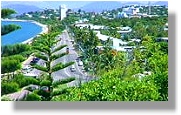| Environmental
The two micro-environments along The Strand are a park and beach.
One requires a pleasant, planted environment to provide colour,
natural cooling and microclimate modification for visitors.
The latter - a dune system - requires stability and maintenance,
not just for human users, but to minimise impact on animals and
the environment.
Given Townsville is situated in the dry tropics, planners looked
to plants that were native and required less water, and trees that
provided a good level of shade along the promenade.
16,000 trees and shrubs, 900 palms and 22,500 native groundcover
plants were planted during the redevelopment.
 Matt
and Meghan from Canada.
Matt
and Meghan from Canada.
“Townsville is our favourite
city that we have been to and The Strand is beautiful. Having
Strand Park in the centre of The Strand is very convenient.”
|
- All shrub and accent plants were locally grown
- Plants with low nutrient requirements were used to ensure nutrient
leaching is minimised
- The need for mechanical maintenance has been minimised by the
choice of plants including evergreen bulbs and compact and tight
forms of shrubs
- The turf (Greenleas Park Couch) was chosen as it has lower
water and nutrient requirements than other high quality turfs.
On the beach front the locally occurring Ipomea pescaprae
(Goat’s foot convolvulus), Canavalia maritima (Beach
Bean) and Spinifex sericeus (Beach Spinifex) were planted
as tube stock and now prevent erosion of the dunes.
The dune systems are well marked and signs warn pedestrians and
beach goers against walking on areas of rehabilitation.
Greencorp projects have targetted weed growth in the dune
systems.
The Indo-Pacific Turtle Management Group and Queensland Parks and
Wildlife work closely with The Strand Management during turtle breeding
season and monitor turtle
nestings along The Strand beach. The four beaches are
turtle breeding grounds, and a comprehensive turtle protection plan
is in place.
Important seagrass beds offshore are protected. Fill was used to
prevent fine sand washing out and smothering the grass. Seagrass
health and turbidity levels are monitored.
The Strand
Wind Project adds an element of environmental foresight to sustainability
research.
A 200 metre watercraft exclusion zone is marked by a sign on the
outer marina rockwall, to minimise noise pollution from watercraft
such as jet skis.
 Other
basic sustainability measures include: Other
basic sustainability measures include:
- All taps and beach showers are either springloaded or have automatic
shut off systems
- Lights are turned on by sensors and turned off by timers.

|


